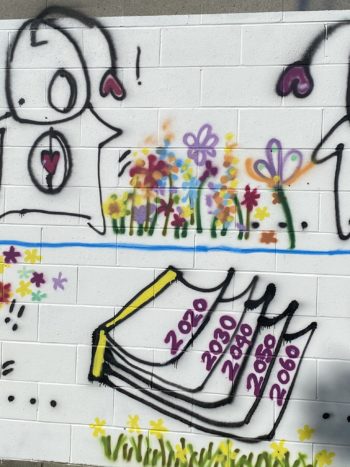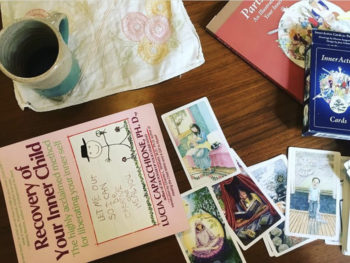If you look at most therapist bios, be it on their Psychology Today profile or on an Instagram landing page, you’ll notice that we specialize in “life transitions.” What does that actually mean though? I know for me, it means helping people be able to feel grounded to some degree when inevitable change happens. It means holding space and being witnessed in this sea change.
Since we are humans, we are constantly evolving, and change will happen, whether we like it or not. We’re not meant to stay the same or have our course be rigid. We’re actually meant to course correct when we are thrown curveballs, whether it is a global pandemic, a break-up, or a loss or maybe also meeting the love of your life or finding your dream job. All of it still takes time to embrace the transition.
We need to take pause and notice that life transitions are only one step in rites of passage. Our way of identifying life transitions needs to be updated and decolonized, and actually know it as a more soul-led practice that involves ceremony and acknowledgement.
So one thing I love is zooming out of our personal experience and noticing the universality of it. And guess what, there are archetypal stories that also reflect our own human experience. It’s a beautiful balance of our humanity and the divinity within all of us. This is where I have deepening in my own life as well as practice as a therapist, holding space for folks and their transitions, while also being able to let them know that while their stories unique, their experience is also universal.
We’re not as special as we think and yet maybe that’s a good thing.
For instance, a lot of us may know the concept of the hero’s journey by Joseph Campbell. In fact, I know I’ve spoken about it previously in other articles here. One thing that I’ve been sitting with though is how linear and masculine-based it is, and so i wanted to find something that felt more aligned with my own story and journey to full consciousness. I’m really relieved that there has been a resurgence of more feminine embodied archetypal stories, ones that have been pushed under the surfaces decades ago.
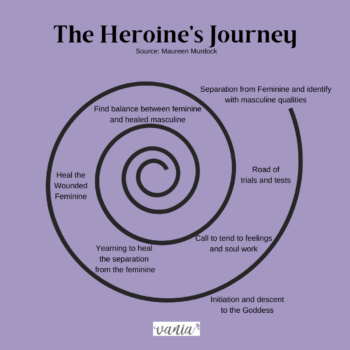 Take Maureen Murdoch’s book, The Heroine’s Journey: Woman’s Quest for Wholeness for example. This book has been pivotal in my own life’s transitions. If you want to learn more about the concept of a heroine’s journey, this article is very helpful.
Take Maureen Murdoch’s book, The Heroine’s Journey: Woman’s Quest for Wholeness for example. This book has been pivotal in my own life’s transitions. If you want to learn more about the concept of a heroine’s journey, this article is very helpful.
The feminine path shows us a different way. One where we step out of current machine and decide to do things on a more full and authentic, more soul level. This isn’t about doing it without honouring our masculine side, but rather integrating both sides of this coin.
As i approach 50, i’m noticing how my own story thus far fits really well into the spiral path. When I was a teenager, I learned some things about my parents lifestyle that didn’t resonate with me. I also knew that I didn’t want how they modelled partnership to be what I carried further in my own story. And then in my mid-20s, I really rejected my feminine side. I cut my hair short, I wore doc martens and hung out with boys more than women. Only then to notice in my 30s that not only did I deeply cherish my relationships with women, my body also just felt more safe and comfortable in their presence – most jobs in my life have been in the community of women-identified folks.
So of course, this is how my path was already carved out for me. It all makes sense now, and i love that it’s a spiral path and not a linear narrative storyline. There is ebb and flow, back and forth, learning and unlearning, and coming back again. The oracle cards i bought at 22 are now a big part of my life. I dusted them off a few years ago, after being shelved away for years. I’m back again where I was before and yet I’m all together new. Now I am more embodied in this knowing and deep understanding. I’m looking back with perspective and wisdom. The 20-year old me who rejected being a woman, or being in service with my feminine power is in awe with where I am now.
As I close in on my halfway point in life, I’m reflecting back in my own timeline. I’m not surprised how well it fits in the path, nor how these archetypal stories of Maiden Mother Crown (and all the other ones) fit into my own journey through life.
I’ve been reflecting on how i got here, so that i can also support others weave their internal threads more intentionally. I have been midwifing my own midlife with such love and care, and feel called to offer this to others. I find this especially true for women who have had difficult relationships with their mothers, maternal lineage, or relationships with women where a lack of eldership and matriarchal wisdom is lacking. I have been going through my own rite of passage with fine grain detail and have noticed some things that i did intuitively really fit with The Spiral Path. It is about embracing a plan of action, that is saturated with an embodied sense of self-control and empowerment.
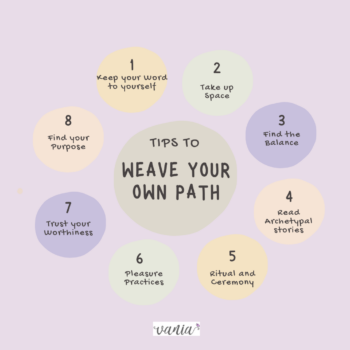
1) Keep your Word to Yourself
Are you the first person you break a promise to? How often do you put your own needs (and dreams) at the bottom of your priority list. This martyrdom does not serve anyone. The laundry can wait, the dishes can be done by someone else, and everyone wins when you honour your soul’s calling. It can be by reading a book that moves you, attending a circle, dancing under the full moon. Whatever it is, make a commitment to yourself to honour your own promise to yourself. No one else will.
2) Take up Space
I recently went skating with my kid and her school. I was amazed by how these children took up space – on the ice, and also everywhere. I learned along the way to apologize for the space i took up, and then resented that i felt invisible. Now, i make a point to share about my own day at dinner, I set a goal for something I want to do on the weekend, I claim my rightful seat on the couch during family movie night, I screamed with joy during the recent Eclipse, and yelled “this is orgasmic” without a care in the world for who heard me.
3) Find the Balance within Masculine Go and Feminine Flow
This one was a hard one for me. After first abandoning my soft feminine side in my early 20s, i then learned how i internalized patriarchy and capitalism in my body. I saw ways that i was neglecting my own soft strengths and having a balance of both qualities and energies is what makes us whole. I can be a good business owner AND also work in the space of feelings and community. In fact, i need both in order to stay resourced and sustainable in my work.
How this looks for each of us is unique, and doesn’t have to be 50/50 to be balanced. It’s about embracing the universal truth that these qualities are not necessarily gendered but rather energetic.
4) Learn about Archetype Stories
Having a map that shows us the way is not only helpful, it is a practice of self-compassion. Learning about fairy tales and goddess stories has been a big part of my journey with my own life transitions. The book Women Who Run with the Wolves is my bible, for instance. I see myself in the stories. I also see more fully the stories of my ancestors and lineage. This is both humbling and reparative.
Archetypal stories allow space for nuance as well as the duality of honouring the humanity and divinity in all of us.
5) Honour Life with Ritual and Ceremony
Rituals are the ways we tend to ourselves and remind us that the only life we are living is our own. They enhance our experience, and carve out a path with intention and self-love. Ceremony is the way we can be witnessed for who we are by others, as we cannot go through rites of passage and life transitions alone. If you need some more guidance, check out my Instagram post here for some inspiration.
6) Pleasure Sorcery
I am so thankful to adrienne maree brown for the term ‘pleasure activist.‘ The opposite of pleasure is feeling numb, partly due to grief that has not been cared for. I wholeheartedly believe that the absense of pleasure is what is causing so many people midlife crisis, existential crisis and burn-out. Access to pleasure and joy were taken from us, or at least shunned into our collective shadow. In a Come to your Senses podcast episode, Mary shares more about how to have courage to be more your Self.
I am a Pleasure Witch, alchemizing the change that happens when we eat the best fucking chocolate mousse in your life, slowing down your partner in a sexual romp to access your own climax, marinating in new lilacs blossoms so that you can savour their smell. To source yourself in pleasure means giving yourself permission to slow down, take pause, awaken your senses.
Still unsure about this? You are not alone – the word pleasure still harbours some negative connotations. How about a practice of gentle pleasure? Try the 5% concept – what is something you can do to make it just a bit more enjoyable – is it playing music while you clean the bathroom, or fresh flowers by your bedside, or maybe it’s a delicious piece of pie to have with your taxes.
7) Trust you are Inherently Worthy
And here’s another tricky one – we need to reclaim that we are inherently worthy simply because we are alive. Our worth should not be tethered to our achievements, busy-ness, productivity. That is a patriarchal, white supremist and capitalist mindset. That keeps us stuck in hustle culture and a stressful experience. When we reclaim our worth, that is our success that will lead to a sense of abundance from a heart-centred and balanced life. Our worth is the value you bring to your own life, and will ripple out to how you impact other beings.
It is a process to reclaim this truth. When i started to learn that i had not just permission but the right to enjoy my own life, and not live vicariously through my children, i started to make sure i added my own projects, plans, and pleasure into our calendar. Nora Roberts shared a fabulous analogy – as a prolific writer, she was asked how she can prioritize and plan out time for writing: it’s all about making sure you catch the right balls.
8) Find Your Purpose
I knew since i was a kid that i was going to be a therapist of some kind. For years, i wanted to be a marine biologist but science and math are not my forte or passion. Being in water and living like a mermaid was not enough reason. When i started my journey as a therapy student, i thought i would be a child psychologist. The fact, it just dawned on me as i’m writing this that i did an undergrad program in HUMAN Development. Of course i was destined to support folks with life transitions.
Now that i’ve been a working therapist for over 18 years, and the years before that in abused women and children’s programs, it all makes sense how my work life is in service for others healing and growth. It is my life’s calling, and is the passion that gives my life a direction.
I am also more than my work, and my roles in life. I am a being who is whole unto herself – i am home.
To Come Home to Yourself
May all that is unforgiven in you
Be released.
May your fears yield
Their deepest tranquillities.
May all that is unlived in you
Blossom into a future
Graced with love.”
~ John O’Donohue, To Bless the Space Between Us: A Book of Invocations and Blessings


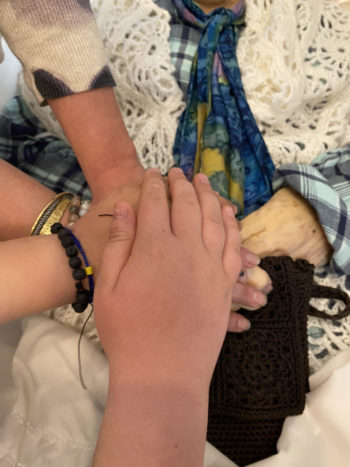
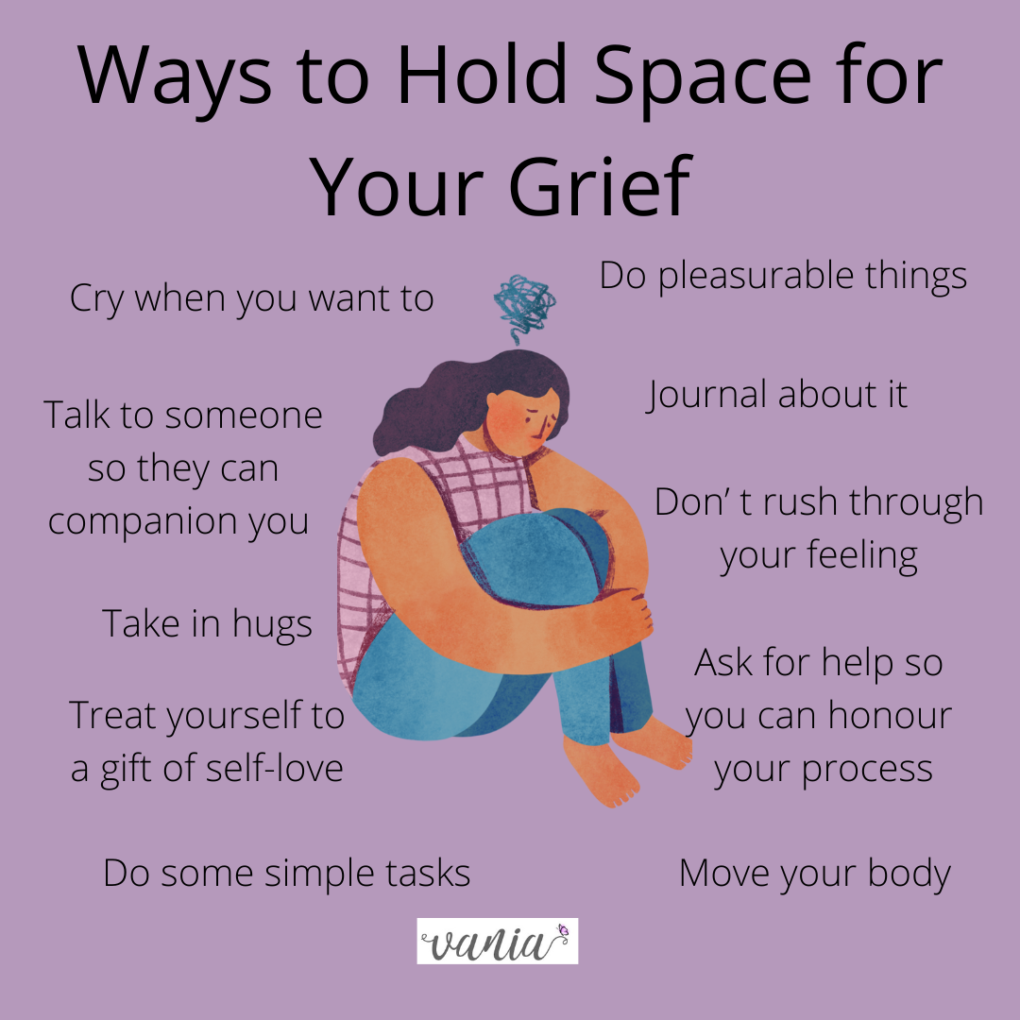
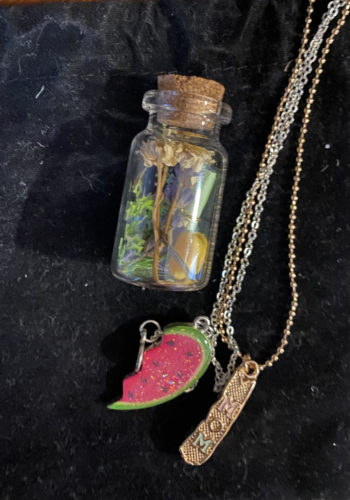 My family doesn’t have any rituals for death to honour, so my sister and i found ways to do it for ourselves. We created rituals that felt right and meaningful for us.
My family doesn’t have any rituals for death to honour, so my sister and i found ways to do it for ourselves. We created rituals that felt right and meaningful for us. 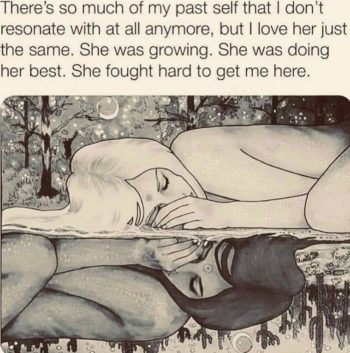 We are not meant to bounce back. We are not the same as before. We are not yo-yos or slinky toys. We may be better or not but we are clearly changed. We all die these little deaths in our lifetime, because we are supposed to.
We are not meant to bounce back. We are not the same as before. We are not yo-yos or slinky toys. We may be better or not but we are clearly changed. We all die these little deaths in our lifetime, because we are supposed to. 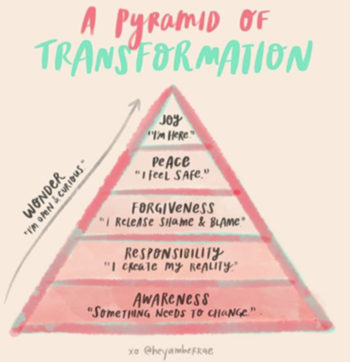
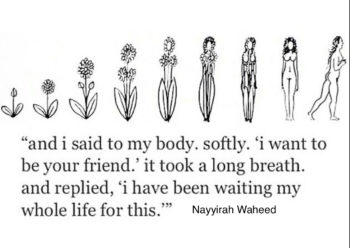

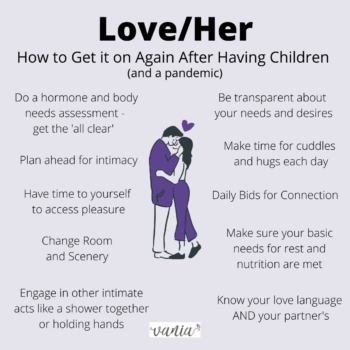
 My kids have been wanting to paint the walls. And not just figuratively, which they surely have been doing during this pandemic. They have been admiring the graffiti and street art in our city, and need to look no further than our own alleyway. Some artwork merits a smile and blush, others are thought-provoking, and some are eye-rolling.
My kids have been wanting to paint the walls. And not just figuratively, which they surely have been doing during this pandemic. They have been admiring the graffiti and street art in our city, and need to look no further than our own alleyway. Some artwork merits a smile and blush, others are thought-provoking, and some are eye-rolling. 